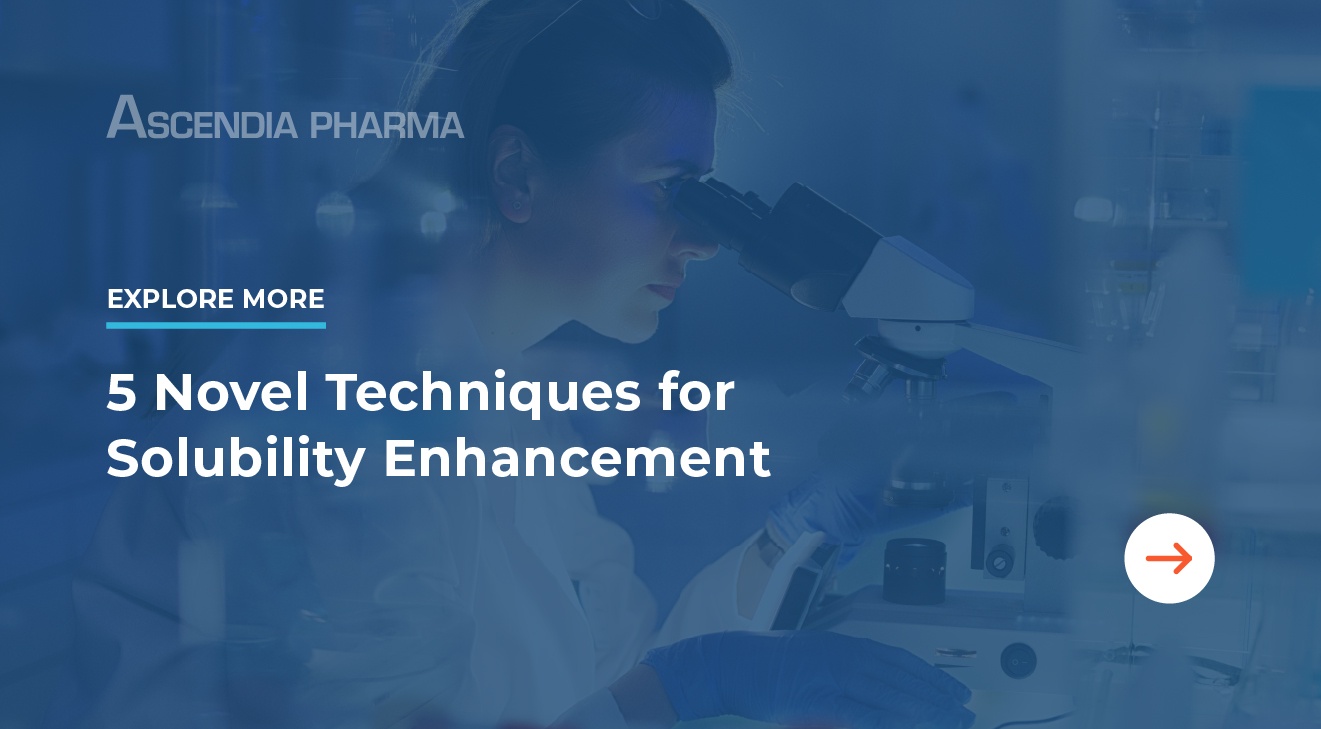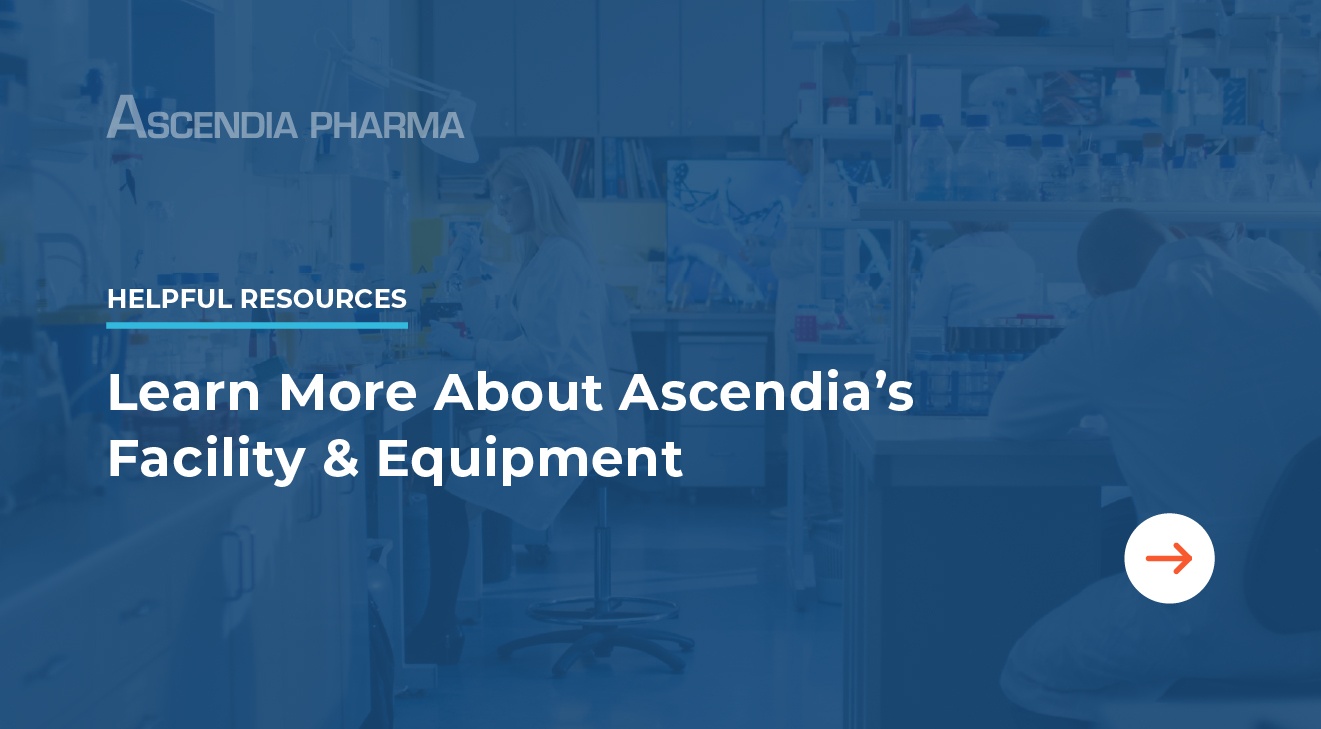Wet Milling vs. Dry Milling in the Pharmaceutical Industry
Milling is used across a number of different industries and can be broadly divided into two types: wet milling and dry milling.
When it comes to the manufacturing of pharmaceuticals, the particle size of ingredients is critical to a drug’s performance and efficacy, so the stakes are much higher than when milling foods or other consumer goods. Choosing between wet milling and dry milling for a specific active pharmaceutical ingredient (API) requires careful consideration and a keen understanding of both methods of particle size reduction.
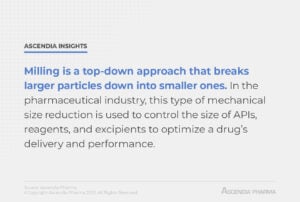
Milling for Particle Size Reduction in Pharmaceutical Manufacturing
Milling is, quite simply, applying energy through mechanical forces to break down particles into smaller sizes. This can be accomplished by using grinding media, screens, pegs, pebbles, or rods; the process may also be described as grinding, granulation, size reduction, comminution, or pulverization.
Milling is a top-down approach that breaks larger particles down into smaller ones, compared with a method like precipitation, which is a bottom-up method that constructs molecules from a dissolved state.
As particles are forced through the mill, they are torn or crushed, thus reducing their size. Milling is used for a number of different purposes in different industries, but in the pharmaceutical industry, this type of mechanical size reduction is used to control the size of APIs, reagents, and excipients to optimize a drug’s delivery and performance.
APIs are commonly isolated via crystallization, then the solids are filtered and dried. Sometimes, the isolated crystals are suitable for use in a drug as-is, but when the particle size distribution (PSD) is not ideal, further processing is needed, which often means the material must be milled.
Whether wet or dry, milling increases the surface area of a solid, which increases its dissolution rate and, in turn, its bioavailability. It ensures that formulations are consistent from one batch to the next, and it can improve an API’s ability to mix with excipients. Milling is one of the most common techniques used to address poor solubility in a new drug compound, not only because it’s effective, but also because it’s inexpensive compared to other methods.
Small particles are particularly desirable in formulations for respiratory, transdermal, and parenteral use. As milling technology advances, manufacturers are able to produce microparticles and nanoparticles easily, efficiently, and affordably. Nanosuspensions, for example, are being investigated for organ and cellular delivery in the treatment of a number of diseases and conditions, including malaria, HIV/AIDS, and other infectious diseases. That said, even liquid and solid oral formulations often require an API to undergo the milling process.
There are, however, some situations in which milling is not an appropriate particle size reduction technique. If milling produces a large amount of fines, or particles that are smaller than desired, milling isn’t ideal as it can create obstacles in processing; for example, if wet milling is used, fines can pass through the filter and result in a lower yield.
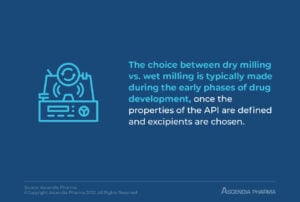
Wet Milling vs. Dry Milling: What’s the Difference?
When the particle size of an API is changed, its properties change. In choosing between wet or dry milling, it’s important to take into consideration any possible changes in safety and therapeutic efficacy, as well as an API’s physical and chemical properties. The choice between dry milling vs. wet milling is typically made during the early phases of drug development, once the properties of the API are defined and excipients are chosen.
Pharmaceutical Wet Milling
Wet milling involves suspending a solid in a liquid; sometimes it’s also referred to as slurry milling. As the slurry is circulated through a wet mill, the particle size is reduced; the slurry continues to recirculate until the desired particle size is reached. Generally speaking, wet milling is preferred to dry milling, and it has a number of distinct advantages.
Advantages of Wet Milling Pharmaceuticals
First, wet milling can be used with terminal isolation to remove impurities through decantation or filtration. The result is a more streamlined manufacturing process that reduces the amount of time needed to produce a drug. In addition, wet milling provides more flexibility in how the crystallization process is carried out, and the same solvents used as liquids to form the slurry in wet milling can be used downstream for formulation processing.
Wet milling is also ideal when an API or excipient is heat-sensitive and cannot be subjected to higher temperatures. Whether wet or dry, milling creates heat, but in wet milling, the liquid works to quickly dissipate this heat, so operating temperatures are not as high. This protects the API from being compromised by high temperatures.
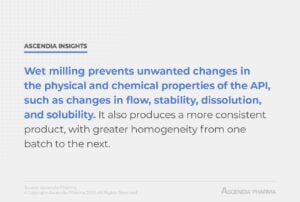
Wet milling also avoids some of the disadvantages of dry milling; namely, it prevents unwanted changes in the physical and chemical properties of the API, such as changes in flow, stability, dissolution, and solubility. Wet milling produces a more consistent product, with greater homogeneity from one batch to the next. Dry milling, in contrast, can have a negative impact on the physical properties of an API by creating surface defects and amorphous material.
As a closed system, there is little-to-no yield loss with wet milling, while some dry milling techniques can have significant yield losses. This closed system also protects the product from outside contaminants, and it protects operators from exposure to potent APIs, which is a serious safety concern in the manufacturing of pharmaceuticals.
Types of Wet Milling
There are a few different types of machines that can be used in the wet milling process:
• Toothed rotor-stator mills – These mills have a rotor, or rotating shaft, and a fixed concentric stator; as the slurry passes through, particle size is reduced by both collisions and high shear.
• Colloid mills – Colloid mills are a form of rotor-stator mills that involve a conical rotor that rotates inside a conical stator. Changing the gap and rotation rate changes the particle size created.
• Media mills – Also known as pearl or bead mills, media mills have a milling chamber, shaft, and recirculation chamber. Inside the chamber is spherical milling media; as the shaft rotates, the milling media moves and creates high shear forces. The particles are ground through particle-particle, particle-media, and particle-wall collisions. This method can be used to create nano-particles.
Pharmaceutical Dry Milling
Dry milling involves placing solids in a feed hopper; the feed hopper then delivers a constant flow through a feed device and, then, the milling unit. Grinding mechanisms can vary, but particles are reduced in size either by colliding with other particles (particle-particle) or through colliding with grinding media or walls. Once the dry milling is complete, the particles exit the grinding chamber and are conveyed to product collection or a classifier, which can return larger particles to the feed hopper to go through milling a second time. (Despite this, dry milling is still considered a single pass process, as it’s not a closed loop like wet milling.)
Advantages of Dry Milling
As mentioned above, when APIs are crystallized, sometimes they are suitable for formulation as-is, while other times, the particles are larger than desired and they must be subjected to particle size reduction. There’s also a third scenario: a pharmaceutical manufacturer may deliberately grow particles larger than the target PSD in an effort to reduce the filtration time needed during isolation. In such cases, wet milling can reduce API purity and dry milling is used instead.
Generally speaking, wet milling is preferred to dry milling in most scenarios, but this isn’t always the case. Sometimes a processing solvent is incompatible with certain types of wet milling equipment, and it has the potential to cause corrosion or other damage. Dry milling may have a process advantage for certain isolations, such as impurity removal or rejection that’s the result of selective crystallization and the rapid removal of liquors.
Other advantages of dry milling include the smaller footprint required for dry milling equipment, lower costs (although this may be offset by the cost of material losses), and easier scalability when moving from development to production.
Types of Dry Milling
When dry milling is used in the manufacturing of drugs, it typically involves one of the following pieces of equipment:
• Hammer mills – These machines feed solids through a series of spinning hammers that reduce particle size by smashing them.
• Pin mills – Pin mills operate in a similar manner as hammer mills, but they work at faster speeds and have less space between the rotating and stationary pins.
• Jet mills – Jet mills micronize particles by using high velocity gas streams to create particle-on-particle collisions.
Learn More About Drug Development, Formulation, and Manufacturing with Ascendia
At Ascendia, we have dry milling and wet milling capabilities for pharmaceuticals, and specialize in working with difficult formulations, poorly soluble drugs, low bioavailability drugs, and nano formulations.
With an ever-increasing number of poorly water soluble drugs coming through the drug discovery pipeline, partnering with a contract development and manufacturing organization (CDMO) that has experience in working with these materials is more important than ever.
To learn more about how Ascendia Pharmaceuticals can help support your operations in this competitive industry, contact us today.
